How they Fought. Indigenous Tactics and Weaponry of Australia’s Frontier Wars
As we head toward a referendum on the Voice to Parliament later in 2023, history looms in the rear vision mirror. The future success of the Uluru Statement of the Heart’s goals of Voice, Truth and Treaty are all deeply linked with how Australians view their past. Growing support for truth-telling in particular is emblematic of a broader shift in the way we understand – or want to understand – the wars of conquest over Aboriginal lands that occurred between 1788 and around 1930. These wars have had little recognition in places of national memory such as the Australian War Memorial, but now these places can’t possibly continue to avoid it.
READ REVIEW
↓
How they Fought. Indigenous Tactics and Weaponry of Australia’s Frontier Wars
Ray Kerkhove | 2023
Historians have been writing about the Australian Frontier Wars in earnest since the 1970s, yet in all this time there has been little effort to systematically understand First Nations tactics and strategies beyond calling it ‘guerrilla warfare’. How they Fought finally gives us a platform to truly recognise the skill, complexity and bravery of warriors generally combatting far superior technologies and military capabilities. At last we are beginning to see just how this great conflict for Australia – one of the longest running conflicts in world history – was conducted with all the trappings of organised, united resistance.
To comprehend how Aboriginal people fought, perhaps we (non-Aboriginal people) have first needed to understand why they fought. Disentangling complex motivations – from defence of Country to responding to massacre, disease and conflict over women on the frontier have already been analysed. Kerkhove moves beyond this into the operations of battles and skirmishes, of raids and counteroffensives. He gathers small specks of archival evidence (European observations) and brings them together in a powerful study of resistance warfare.
Kerkhove includes extensive maps, tables and diagrams that show typical tactics and manoeuvres. We are familiar with such maps and diagrams in the volumes of Australian military history but, to my knowledge, no historian has taken this approach to Aboriginal military history. Kerkhove treats the more than one hundred years of wars against colonial occupation with a seriousness that not only explains ‘how they fought’ but sends a message to Australian military historians to look at their own backyard, at the Australian Wars.
Despite all the work by historians such as Henry Reynolds, Richard Broome, Jonathan Richards and John Connor, the dominant narrative of the Australian Frontier Wars remains that First Nations people offered a scattered, disorganised resistance and where they were a threat, they were crushed by massacres. When people go to war – and it can only be seen as total war in such moments as the resistance around southern and western Sydney between 1814 and 1816 or the Bathurst War from 1822 to 1824 – they do so with a plan for some kind of gain or positive outcome, rather than a hopeless lost cause. Kerkhove’s forensic analysis sheds light on these strategies – on the opportunities that using terrain or combining forces offered for successfully halting colonial expansion.
His analysis of Aboriginal military structures is ground-breaking. Kerkhove has found multiple examples of the Aboriginal equivalent of military rank and organised units with various roles. Insignia such as feathers often denoted warriors’ roles and leadership status. The number of colonists who reported on the precision of warriors marching in line and formation is astounding. Why have we not thought until now to analyse this in detail? Perhaps largely because our military historians have firmly turned their gaze toward the less irksome, more palatable stories of white Australian Anzac sacrifice.
While I have some areas of disagreement, such as calling the Battle at Broken River a massacre (of armed Europeans) and not a battle, and minor quibbles on equalling warrior forces to Western military units such as squadrons, this is to be expected in a work that covers such a breadth of examples and material.
How they Fought is worth a read from cover to cover but its real value lies in it being a platform for future detailed histories of Australian conflict and war. As historians more closely scrutinise the Australian Wars – and they will, as truth-telling demands it – they now have a resource at hand, a go-to book on the tactics, strategies, weapons and modes of warfare where they can cross reference, with examples at hand. When we come upon a reference to a stockpile of spears and weapons, we can look up the relevant section of How They Fought and find multiple instances for comparison to better understand why weapons were cached and how these were used. This will open many new avenues for historical inquiry. Importantly, we will better appreciate the complex relationship between resistance battles and massacres, and see that the conquest of Aboriginal Australia without any kind of peace treaty arrangement was not a forgone conclusion.
How they Fought is published by Boolarong Press.
Reviewer: Stephen Gapps, PHA (NSW & ACT), author of The Sydney Wars and Gudyarra.

